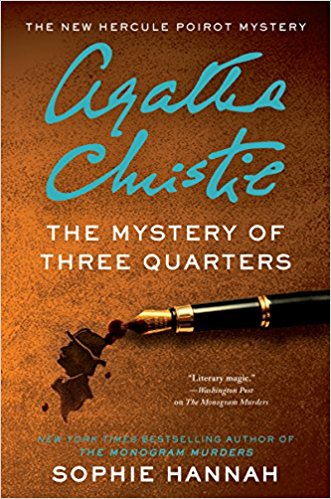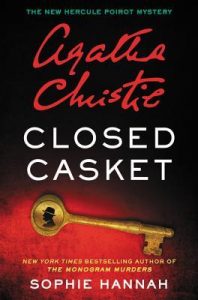 The Mystery of Three Quarters (The New Hercule Poirot Mystery #3) by Sophie Hannah
The Mystery of Three Quarters (The New Hercule Poirot Mystery #3) by Sophie Hannah Format: eARC
Source: supplied by publisher via Edelweiss
Formats available: hardcover, large print, paperback, ebook, audiobook
Genres: historical mystery, mystery
Series: New Hercule Poirot #3
Pages: 368
Published by William Morrow on August 28, 2018
Purchasing Info: Author's Website, Publisher's Website, Amazon, Barnes & Noble, Kobo, Bookshop.org
Goodreads
The world's most beloved detective, Hercule Poirot--the legendary star of Agatha Christie's Murder on the Orient Express and most recently The Monogram Murders and Closed Casket--returns in a stylish, diabolically clever mystery set in the London of 1930.
Returning home from a luncheon, Hercule Poirot is met at his door by an imperious woman who introduces herself as Sylvia Rule. "How dare you? How dare you send me such a letter?" Ignoring his denials, Mrs. Rule insists that she received a missive claiming he had proof she murdered a man named Barnabas Pandy and advising her to confess her crime to the police. Threatening the perplexed Poirot with a lawsuit, she leaves in a huff.
Minutes later, a rather disheveled man named John McCrodden appears. "I got your letter accusing me of the murder of Barnabas Pandy." Calmly, Poirot again rebuts the charge. Each insisting they are victims of a conspiracy, Mrs. Rule and Mr. McCrodden deny knowing who Pandy is.
The next day, two more strangers proclaim their innocence and provide illuminating details. Miss Annabel Treadway tells Poirot that Barnabas Pandy was her grandfather. But he was not murdered; his death was an accident. Hugo Dockerill also knows of Pandy, and he heard the old man fell asleep in his bath and drowned.
Why did someone send letters in Poirot's name accusing people of murder? If Pandy's death was an accident, why charge foul play? It is precisely because he is the great Hercule Poirot that he would never knowingly accuse an innocent person of a crime. Someone is trying to make mischief, and the instigator wants Poirot involved.
Engaging the help of Edward Catchpool, his Scotland Yard policeman friend, Poirot begins to dig into the investigation, exerting his little grey cells to solve an elaborate puzzle involving a tangled web of relationships, scandalous secrets, and past misdeeds.
My Review:
 This is now the third of Sophie Hannah’s New Hercule Poirot mysteries (after The Monogram Murders and Closed Casket), and there is one thing they all have in common. Actually there are several things they have in common, but the one that strikes this reader first is the sheer, compulsive readability of this series. Whether one considers them continuations of the original, homages to it, or a combination of the two, they are all absolutely brimming with can’t-put-it-down-ness. Once I started, I couldn’t stop. All day.
This is now the third of Sophie Hannah’s New Hercule Poirot mysteries (after The Monogram Murders and Closed Casket), and there is one thing they all have in common. Actually there are several things they have in common, but the one that strikes this reader first is the sheer, compulsive readability of this series. Whether one considers them continuations of the original, homages to it, or a combination of the two, they are all absolutely brimming with can’t-put-it-down-ness. Once I started, I couldn’t stop. All day.
Another factor that is common to all three books is the new author’s invented “Watson” for Poirot, Inspector Edward Catchpool. Unlike poor Japp in the original series, Catchpool is a young detective, early in his career. While he sometimes (often!) chafes at being caught between his Super’s orders and Poirot’s “requests”, he is aware that he needs Poirot.
One of the gratifying parts of their relationship is the way that Poirot also seems to be aware that he needs Catchpool, and not just to provide official sanction. Poirot is always the lead partner, but there is a partnership developing.
The case in The Mystery of Three Quarters feels very Poirot in that it is convoluted in the extreme. Someone has sent letters, signed by Poirot, accusing the recipients of murder. The four recipients of those letters are various shades of indignant and perplexed. Poirot is incensed, because he did not send the letters – and their grammar and writing style is absolutely appalling. Instead he discovers that the supposed murder victim surely died by accident, and that his purported murderers don’t seem to have much relationship to each other – or even to the late, more-or-less lamented Barnabas Pandy.
It’s up to Poirot, with the able assistance of Inspector Catchpool, to figure out, not so much whodunit, but whydunit, before somebody else gets done.
 Escape Rating B: It’s the must-keep-reading-ness aspect of this book that sticks with me. The case, as bizarre as it is (and Poirot’s cases were often a bit “out there”) pulls the reader along from sentence to sentence and paragraph to paragraph and doesn’t let go until the end.
Escape Rating B: It’s the must-keep-reading-ness aspect of this book that sticks with me. The case, as bizarre as it is (and Poirot’s cases were often a bit “out there”) pulls the reader along from sentence to sentence and paragraph to paragraph and doesn’t let go until the end.
In other words, The Mystery of Three Quarters is a whole lot of fun to read.
Three books into this “new” series, I still feel as if it is more of a continuation of the TV portrayal of Poirot than the original books – or perhaps it’s just that Poirot’s extreme quirks feel even more quirky when one visualizes David Suchet’s performance than they must have when originally published. I always hear Suchet’s voice while reading this new series. Your mileage, of course, may vary.
One thing that stands out from The Mystery of Three Quarters is the utter wackiness of the entire case. As a device to get Poirot involved, the fraudulent letters are a stroke of both absurdity and genius. No one could resist getting to the bottom of the whole mess, and certainly Poirot is incapable of letting someone else take his name in vain. He can’t resist, which was the whole point.
Also the killer’s mistake, but of course that’s all part of the big reveal at the end.
One of the things that surprised me about the entire farrago was just how much of Poirot’s resolution turned out to be based on slightly far-fetched assumptions about motives and emotions. There’s not a whole lot of forensic evidence in this case until the very end. Instead it’s all about what people thought and how they felt and why they subsequently acted the way they did.
 It all gallops along brilliantly as its going on, but looking back I’m not quite sure it all hangs together. But still, it was a terrific ride while it was happening, and I enjoyed every page of it.
It all gallops along brilliantly as its going on, but looking back I’m not quite sure it all hangs together. But still, it was a terrific ride while it was happening, and I enjoyed every page of it.
I’m very happy that the author is continuing this “collaboration” with the late Dame Agatha Christie, and I look forward to more installments of Hercule Poirot’s “new” mysteries!
But I still like the UK covers better for this series. It’s Poirot. It’s the 1930s. Art deco is the right look and feel. Just run with it!






















I really enjoy this genre. Thanks for the heads up on these!
Laura Thomas recently posted..Shadow House ~ The Missing ~ Blast and Giveaway
They are just so much fun. And if you haven’t seen the PBS series with David Suchet as Poirot they are a real treat!
Marlene Harris recently posted..Review: Under Control by Shannon Stacey + Giveaway
I’ve always been a fan of Poirot – I’m looking forward to more stories featuring his unique self!
Thanks for being on the tour.